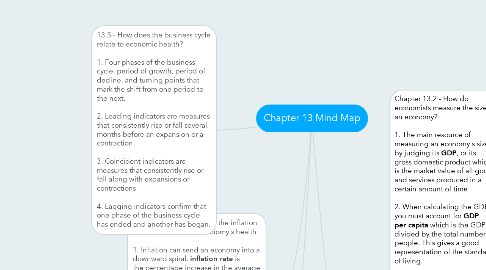Chapter 13 Mind Map
by JACOB GACKLE

1. Chapter 13.3 - What Does the Unemployment Rate Tell Us About an Economy’s Health? 1. Every month, the BLS reports the total number of people who were unemployed for the previous month. To arrive at this figure, the BLS does not attempt to count every job seeker in the country. Instead, it conducts a sample survey each month. By examining a small but representative sample of the population, the BLS can gauge how many people in the entire population are unemployed. 2. There 4 different types of unemployment. **frictional unemployment** which is being in between jobs. This is usually short term. **structural unemployment** is when a job is no longer in demand so you become unemployed. **seasonal unemployment** is when you only work for certain times of the year so sometimes you're unemployed. **cyclical unemployment** is when people simply lose their jobs because the GDP has dropped. 3. When an economy reaches full employment, jobs exist for everyone who wants to work, even though a certain percentage of those jobs and workers will not yet have been matched together. Economists call this percentage the **natural rate of unemployment**. This rate has varied historically, but has generally ranged between 4 and 6 percent. 4. Despite its flaws, the official unemployment rate serves as a fairly good indicator of conditions in the labor market. And in general, when the rate is high, the overall health of the economy is poor. The main economic cost of high unemployment is lost potential output. The smaller the number of people who are working, the fewer goods and services the economy can generate. Potential output is lost because labor resources are not being fully utilized. An increasing unemployment rate, then, means a decreasing real GDP.
2. Chapter 13.4 - What does the inflation rate reveal about an economy's health 1. Inflation can send an economy into a downward spiral. **inflation rate** is the percentage increase in the average price level of goods and services from one month or year to the next. 2. Tracking the inflation is done with **consumer price index** is a market basket of goods and services. 3. Another way of tracking inflation is **cost-of-living-index**. It's an accurate way of depicting the total cost of living 4. When accounting for how much things cost you must adjust for the **real cost of living** which is the goods and services adjusted for inflation.
3. 13.5 - How does the business cycle relate to economic health? 1. Four phases of the business cycle. period of growth, period of decline, and turning points that mark the shift from one period to the next. 2. Leading indicators are measures that consistently rise or fall several months before an expansion or a contraction. 3. Coincident indicators are measures that consistently rise or fall along with expansions or contractions 4. Lagging indicators confirm that one phase of the business cycle has ended and another has began.
4. Chapter 13.2 - How do economists measure the size of an economy? 1. The main resource of measuring an economy's size is by judging its **GDP**, or its gross domestic product which is the market value of all goods and services produced in a certain amount of time 2. When calculating the GDP you must account for **GDP per capita** which is the GDP divided by the total number of people. This gives a good representation of the standard of living. 3. Countries with high GDP's also tend to have higher **literacy rates** - % of people that can write **life expectancy**- average life span and **infant mortality** - the rate at which babies die in their first year of life 4. There are, however, limitations to a GDP. GDP leaves out unpaid household and volunteer work, ignores informal and illegal exchanges, statistics do not count informal or illegal economic activity as part of a nation’s output, counts some negatives as positives, a rise in is not always a good sign, ignores negative externalities, and places no value on leisure time.


